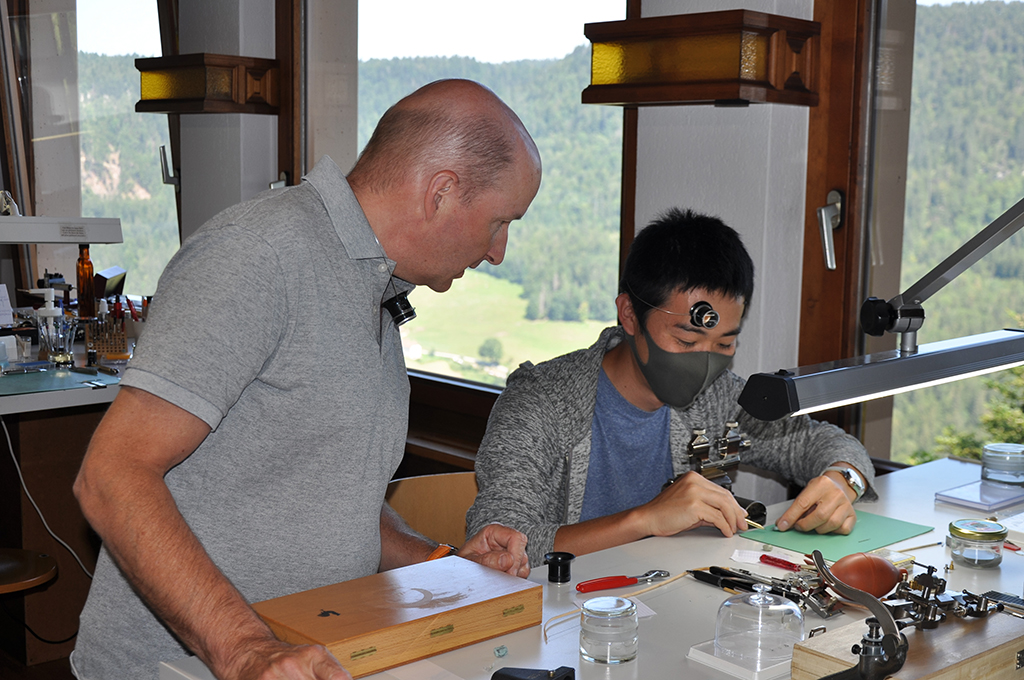A new wave of watchmakers respects classic Swiss designs

The health of the Swiss watch industry is judged not only by exports that soar from one record to the next, but also by the number of new brands founded by young designers and entrepreneurs. SWI swissinfo.ch speaks to members of this new wave of watchmakers.
In the Vallée de Joux, western Switzerland, the watchmaking company Jaeger-LeCoultre has not forgotten Antoine LeCoultre and Edmond Jaeger, the founders of this prestigious luxury brand. In Geneva, Vacheron Constantin keeps alive the memory of its founders, Jacques-Barthélemy Vacheron and François Constantin. Abraham-Louis Breguet no longer leads Breguet, but his presence lives on. The great watchmaking classics are a product of the genius of young visionaries.
Two centuries later, in the years 1990-2000, a cohort of new designers took over the watchmaking landscape: Maximilian Büsser of MB&F, Felix Baumgartner and Martin Frei of Urwerk, François-Paul Journe and Kari Voutilainen, to name a few independent watchmakers whose works now fetch top prices at auction.

This explosion of talent was followed by a period of calm in the Swiss watchmaking world. Few newcomers managed to make it big, with the notable exception of Rexhep Rexhepi, a Geneva resident originally from Kosovo, who founded his brand Akrivia in 2012 at the age of 25.
His rise was swift, and so was recognition from his peers: his Chronomètre Contemporain won the prestigious prize for the best men’s watch at the Grand Prix d’horlogerie de Genève in 2018. Today, Akrivia has established itself as an undisputed benchmark – Louis Vuitton even chose Rexhepi at the end of 2023 for a collaboration. He has become the face of the successful “new wave” in watchmaking.
Subscribe here to read our weekly top stories
The real ‘new wave’ sweeps in
In recent years, Rexhepi has had company. New names are emerging on the watch market. “Guillaume Laidet at Nivada Grenchen and Vulcain, Étienne Malec at Baltic, and Andrea Furlan at Furlan Marri are all part of a new generation of watchmaking entrepreneurs”, says Serge Maillard, a journalist and the editor of the specialist magazine Europa Star.
Another member of this club is unquestionably Nicolas Freudiger, the co-founder of the ecologically aware brand ID Genève, which managed to attract Leonardo DiCaprio as one of its investors. The same goes for Julien Tixier, who creates exceptional timepieces in his workshop in the Vallée de Joux, and Simon Brette, whose Chronomètre Artisans was named a “watchmaking discovery” at the 2023 edition of the Grand Prix de Genève.
Given that the watchmaking industry already boasts more than 300 brands with the “Swiss Made” label, how do you explain the resurgence of newcomers to a market often seen as saturated?
“Some customers are very frustrated with the established watchmaking houses, which are constantly raising their prices and failing to communicate with a new public,” says Guillaume Laidet, a young entrepreneur and watchmaking enthusiast.
The “new wave” artisans target two distinct buyer segments: passionate collectors and the general public who love watches. Akrivia, for instance, focuses on wealthy connoisseurs in search of the originality and quality they no longer necessarily find at the major manufacturers, which reserve their most exclusive pieces for a closed circle of loyal and historic buyers.

Patek Philippe is particularly renowned for its rigorous approach to the buyers of its rarest timepieces: potential customers have to earn the privilege, just as they must do to obtain a Hermès bag. Faced with these practices, a younger generation of self-made millionaires prefers to approach designers of the same age directly.
The advent of the internet has made their work more visible. “We had to struggle for decades to explain what we were doing. They just put their designs on Instagram and dozens of people come running up to them shouting ‘Take my money!’”, says Maximilian Büsser, a watchmaker and the founder of the MB&F brand.
However, a young brand that has produced a few masterpieces can disappear as quickly as it appeared, leaving behind a trail of fancy watches that are unfortunately impossible to repair. Even so, some watch-lovers are prepared to take the risk out of curiosity, or out of a desire to support the development of watchmaking.
New designers for a new clientele
Driven by the desire to revive Swiss brands that have fallen into obscurity, Laidet acquired Nivada Grenchen and Vulcain. In 2020 he relaunched the first, which was founded in 1926. The second, which came into existence in 1858, was relaunched in 2021. He regrets that he couldn’t add Universal Genève to his collection, another sleeping beauty recently acquired by Breitling.

His strategy differs from that of most watchmakers: instead of producing extremely expensive watches in very small quantities, he creates mechanical watches accessible to the general public. The new brands tend to operate in e-commerce, but remain driven by Swiss values and expertise, which surface in collections that often have a vintage look.
The way the top-performing new watchmakers position their products contrasts with the scene of the 2000s. In extreme cases, it can approach imitation or even counterfeiting: by reproducing the best-sellers of watchmaking aristocracy, some new watchmakers are putting their own names on dials that could have been created by Patek Philippe or Rolex.
This phenomenon comes as a surprise to watch designers from the turn of the millennium, who tended to see themselves as rebels within the industry. “I don’t understand why, instead of challenging the rules as we did, they are content to follow them closely,” says Felix Baumgartner, co-founder of Urwerk. It is true that the advertising sometimes gives the impression these products are the result of someone asking artificial intelligence to produce a watch combining all the Swiss classics.
“We don’t work with AI,” says Laidet with a smile. “We’re not opportunists – we study the catalogues of the time to find inspiration from watches that are most faithful to the image of this or that brand.” He believes that his brands appeal to all generations, from young enthusiasts to seasoned collectors.
“But we all agree on one thing: the new wave of watchmaking corresponds to a new generation of customers,” he says. “This confirms that the classic watch remains fashionable in all circumstances.”
Edited by Samuel Jaberg. Adapted from French by Catherine Hickley/gw

In compliance with the JTI standards
More: SWI swissinfo.ch certified by the Journalism Trust Initiative












You can find an overview of ongoing debates with our journalists here . Please join us!
If you want to start a conversation about a topic raised in this article or want to report factual errors, email us at english@swissinfo.ch.